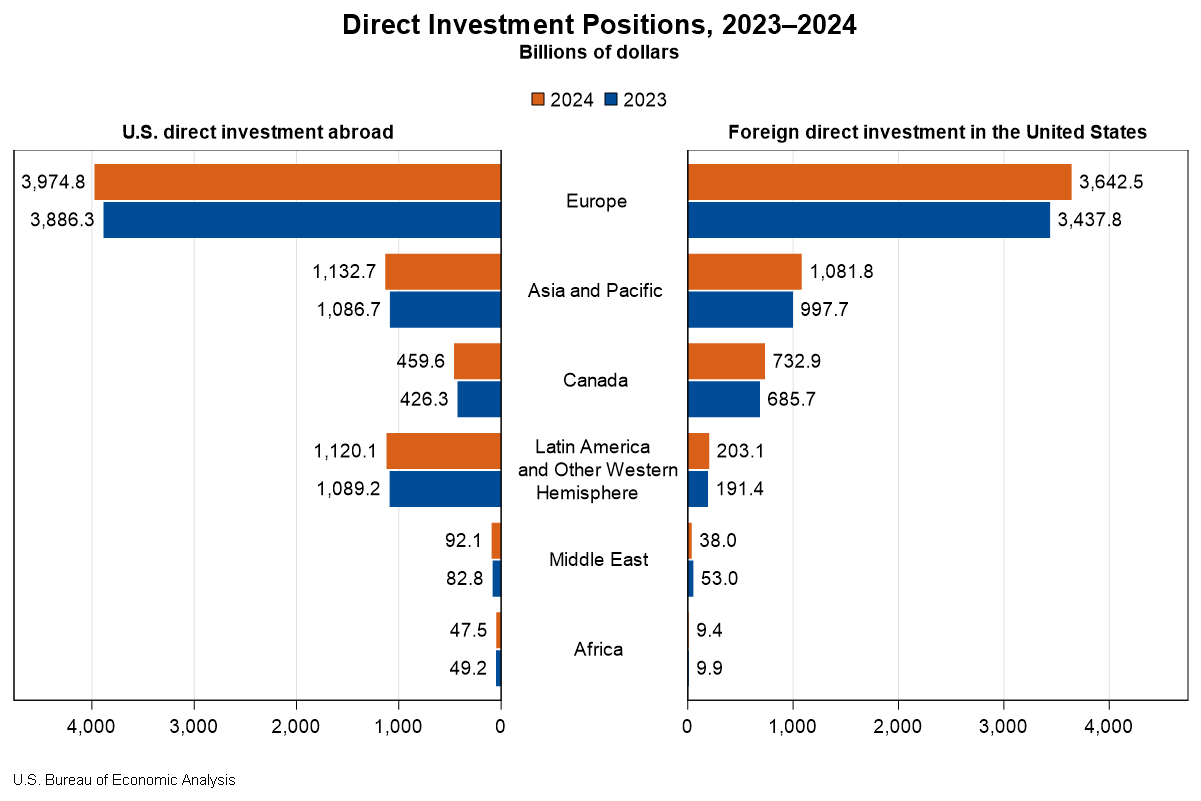Bureau of Economic Analysis
Direct Investment by Country and Industry, 2024
The U.S. direct investment abroad position, or cumulative level of investment, increased $206.3 billion to $6.83 trillion at the end of 2024, according to statistics released today by the U.S. Bureau of Economic Analysis. The increase was led by an $88.4 billion increase in the position in Europe, primarily in Luxembourg and Germany. By industry, manufacturing affiliates had the largest increase, led by manufacturing of computers and electronic products.
The foreign direct investment in the United States position increased $332.1 billion to $5.71 trillion at the end of 2024. The increase was led by a $204.7 billion increase in the position from Europe, which reflected a $52.9 billion increase from the United Kingdom and a $39.7 billion increase from Germany. By industry, affiliates in manufacturing increased the most.
Principal Federal Economic Indicators
Noteworthy
- 2025 News Release Schedule
- Innovation at BEA
- 2025 Annual Updates
- New! Services Trade Data for More Countries
- Data Tool: Trade in Value Added
- Distribution of State Personal Income
- Updated: RIMS II Regional Multipliers
- Arts and Culture
- Space Economy
- FDI Now in State BEARFACTS
- Quick Guide: Price Indexes
The Latest
GDP Growth Moderates in Second Quarter
Real gross domestic product (GDP) rose 1.5 percent in the second quarter after rising 2.0 percent in the first quarter, according to the Bureau of Economic Analysis. According to the 2012 annual revision, the first-quarter growth rate was revised up 0.1 percentage point.
Real GDP second-quarter highlights
Gross Domestic Product, 2nd quarter 2012 (advance estimate); Revised Estimates: 2009 through First Quarter 2012
Real gross domestic product -- the output of goods and services produced by labor and property located in the United States -- increased at an annual rate of 1.5 percent in the second quarter of 2012, (that is, from the first quarter to the second quarter), according to the "advance" estimate released by the Bureau of Economic Analysis.
Revising Economic Indicators: Here's Why the Numbers Can Change
In late June, the Bureau of Economic Analysis (BEA) reported that the economy grew at a 1.9 percent annual rate in the first quarter of 2011. This, our third estimate for the quarter, turned out to be lower than our initial estimate of a 2.2 percent growth rate made in late April. When we revise a major economic indicator, it’s not unusual for some to ask us, “Why didn’t you get it right the first time?”
Quarterly GDP by Industry Data Improves Understanding of the Economy
In 2009, annual gross domestic product (GDP) for durable goods manufacturing showed a double-digit decline. The industry was the leading annual contributor to the bottoming out of the U.S. economy for that year. But looking at the results through a new experimental quarterly data series reveals a more nuanced and complete picture of what was happening in durable goods manufacturing. It shows that the decline in 2009 largely…
If You Respond to BEA's International Surveys, Please Read This!
New changes in the method of informing businesses about requirements for submitting Bureau of Economic Analysis (BEA) surveys will increase the efficiency of the process and reduce paperwork for both survey respondents and BEA. The new procedures involve the collection of data through BEA’s surveys of direct investment and international trade in services.
May Trade Gap is $48.7 Billion
The U.S. monthly international trade deficit decreased in May, according to the U.S. Bureau of Economic Analysis and the U.S. Census Bureau. The deficit decreased from $50.6 billion (revised) in April to $48.7 billion in May, as imports decreased and exports increased. The previously published April deficit was $50.1 billion. The goods deficit decreased $1.6 billion from April to $63.5 billion in May, and the services surplus increased $0.3…
What is the U.S. Current Account?
The U.S. current account is the broadest measure of trade and income flows between the United States and the rest of the world. Together with the capital and financial account, it is a component of the international transactions accounts compiled by the Bureau of Economic Analysis.
Real Disposable Personal Income Picks Up
Personal income increased 0.2 percent in May, the same increase as in April. The increase in wages and salaries was less than 0.1 percent in May, compared with an increase of 0.1 percent in April.
Current-dollar disposable personal income (DPI)—after-tax income—increased 0.2 percent in May, the same increase as in April.
Real DPI— income adjusted for taxes and inflation—increased 0.3 percent in May after increasing 0.1 percent…
Personal Income and Outlays, May 2012
Personal income increased $25.4 billion, or 0.2 percent, and disposable personal income (DPI) increased $18.5 billion, or 0.2 percent, in May, according to the Bureau of Economic Analysis. Personal consumption expenditures (PCE) decreased $4.7 billion, or less than 0.1 percent. In April, personal income increased $29.4 billion, or 0.2 percent, DPI increased $19.5 billion, or 0.2 percent, and PCE increased $16.2 billion, or 0.1 percent, based…




